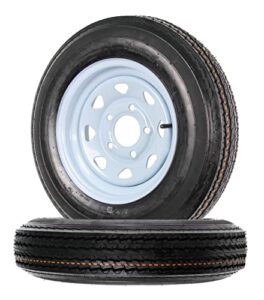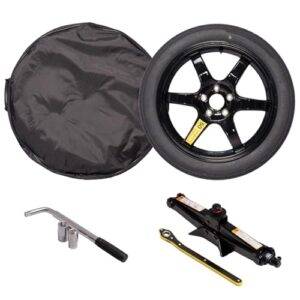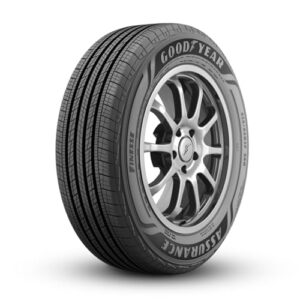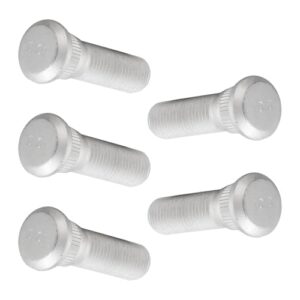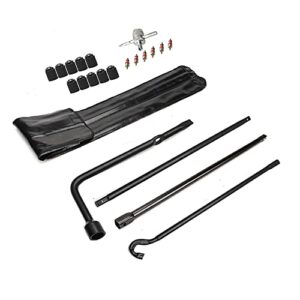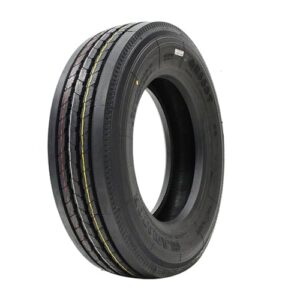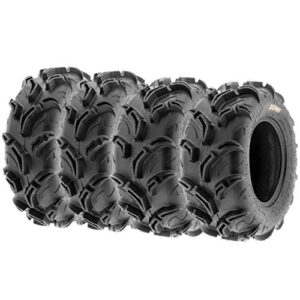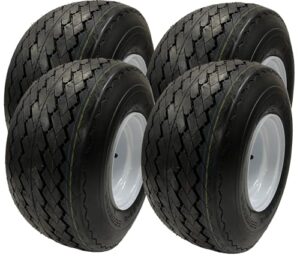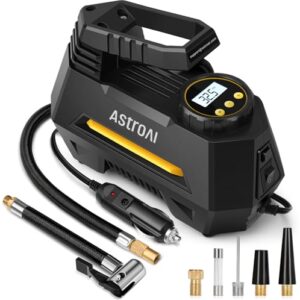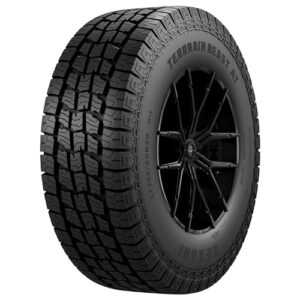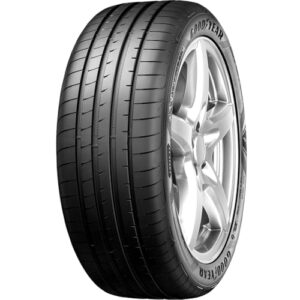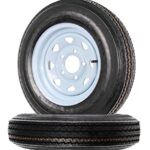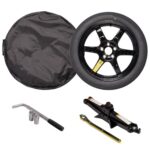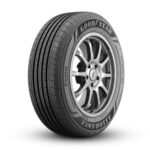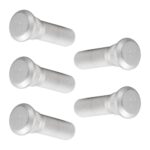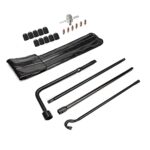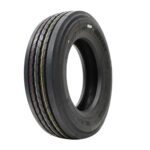Choose tires with a high treadwear rating, good traction, and low rolling resistance. Opt for all-season or touring tires for comfort and durability.
Long-distance driving demands reliable tires that can handle various road conditions and provide a smooth ride. Selecting the right tires ensures safety, fuel efficiency, and comfort during your travels. All-season or touring tires are excellent choices as they offer a balanced performance for highways and diverse weather conditions.
High treadwear ratings indicate longevity, while good traction ratings ensure better grip on the road. Low rolling resistance tires improve fuel efficiency, saving you money over time. Always check tire reviews and ratings, and consult with a professional to make the best choice for your driving needs. Investing in quality tires increases your long-distance driving experience.

Assessing Your Needs
Choosing the right tires for long-distance driving can be overwhelming. One of the first steps is to assess your needs. This involves understanding various factors that impact tire performance.
Driving Conditions
Consider the typical driving conditions you’ll encounter. Are you often on highways, back roads, or city streets? Each type of road has different requirements for tires.
- Highway driving requires tires with low rolling resistance for fuel efficiency.
- Back roads might need tires with better grip and durability.
- City streets usually call for tires that handle frequent stops and starts well.
Also, think about weather conditions. Do you drive in rain, snow, or dry conditions? Different tires perform better in different weather.
| Weather Condition | Recommended Tire Type |
|---|---|
| Rain | All-season tires with good wet traction |
| Snow | Winter tires with deep treads |
| Dry | Performance tires with a smooth ride |
Vehicle Type
Your vehicle type also plays a crucial role in tire selection. Different vehicles have different requirements.
- Cars: Typically need tires with good handling and comfort.
- SUVs: Require tires that offer stability and can handle heavier loads.
- Trucks: Often need all-terrain tires for off-road capability.
Ensure the tire size matches your vehicle’s specifications. Check your vehicle’s manual or the placard on the driver’s side door.
Also, think about the load rating. This tells you how much weight a tire can safely support. Make sure it meets or exceeds your vehicle’s requirements.
Understanding Tire Types
Choosing the right tires for long-distance driving is essential. The type of tire affects your car’s performance, safety, and comfort. Below, we explain two common tire types: All-Season Tires and Touring Tires.
All-season Tires
All-Season Tires are versatile and suitable for most weather conditions. They perform well in both summer and mild winter conditions. These tires are designed to provide a balance of performance, comfort, and fuel efficiency.
Key features of All-Season Tires:
- Good grip on both wet and dry roads
- Longer tread life compared to summer or winter tires
- Quiet and comfortable ride
All-Season Tires are perfect if you drive in areas with moderate weather. They do not excel in extreme weather conditions, so consider your climate before choosing.
Touring Tires
Touring Tires are designed for long-distance driving. They focus on comfort and a smooth ride. These tires offer excellent handling and stability at high speeds.
Key features of Touring Tires:
- Improved comfort for long drives
- Better handling and stability
- Quiet ride with reduced road noise
Touring Tires are perfect if you travel long distances regularly. They ensure a comfortable and quiet ride, making long trips more enjoyable.
Evaluating Tire Durability
Choosing the right tires for long-distance driving is crucial. Durability is one of the most important factors to consider. Durable tires ensure safety and cost-effectiveness over time.
Tread Life
Tread life measures how long a tire can last before it wears out. Look for tires with high tread life ratings. Tires with deeper treads last longer. They also provide better grip and performance.
- Check the Uniform Tire Quality Grading (UTQG) rating.
- Higher UTQG numbers indicate longer tread life.
- Consider all-season tires for balanced performance.
Construction Quality
Construction quality determines how well a tire can withstand long drives. Good construction quality means the tire can handle heat and pressure better. This is essential for long-distance journeys.
| Feature | Benefit |
|---|---|
| Steel-belted construction | Improves durability and strength. |
| High-quality rubber compounds | Improves wear resistance. |
| Reinforced sidewalls | Provides better load capacity. |
Inspect the tire’s sidewall for construction details. Look for features like steel belts and reinforced sidewalls. These features add to the tire’s durability and performance.
Considering Fuel Efficiency
Choosing the right tires for long-distance driving can save fuel. Tires play a crucial role in fuel consumption. Understanding how tires affect fuel efficiency helps in making an informed choice. Let’s dive into key factors to consider for better fuel efficiency.
Rolling Resistance
Rolling resistance is the force resisting the motion when a tire rolls. Lower rolling resistance means less energy needed to keep tires moving. This directly impacts fuel efficiency.
Here are some tips to reduce rolling resistance:
- Choose tires labeled as low rolling resistance.
- Ensure proper tire inflation.
- Regularly check and maintain tire pressure.
| Feature | Impact on Fuel Efficiency |
|---|---|
| Low Rolling Resistance Tires | Improves fuel efficiency by 3-4% |
| Proper Tire Inflation | Can save up to 3% fuel |
Eco-friendly Options
Eco-friendly tires are designed to be fuel-efficient and environmentally friendly. These tires use special materials and technologies to reduce fuel consumption. They also minimize carbon footprint.
Consider these eco-friendly options:
- Tires made from sustainable materials.
- Recycled rubber tires.
- Low rolling resistance eco-friendly tires.
Using eco-friendly tires benefits both your wallet and the planet.
Checking Comfort And Noise
Choosing tires for long-distance driving? Comfort and noise are crucial factors. You want a smooth ride and minimal noise. Let’s dive into how to check these aspects.
Ride Smoothness
A smooth ride makes long trips enjoyable. Check the tire’s sidewall. Softer sidewalls absorb road bumps better. Look for all-season tires. They often provide a balanced ride. Also, read customer reviews. People often mention the ride quality. Consider tires with higher ratings for smoothness.
| Tire Type | Ride Smoothness |
|---|---|
| All-Season | High |
| Performance | Moderate |
| Winter | Variable |
Noise Levels
Noise can ruin a long drive. Quiet tires improve the driving experience. Look for tread patterns. Symmetrical patterns often produce less noise. Also, check for noise-reducing technology. Some tires have special designs to cut noise. Reading user reviews helps too. Users often comment on tire noise levels.
- Symmetrical Tread Patterns
- Noise-Reducing Technology
- Customer Reviews
Prioritizing Safety Features
Choosing the right tires for long-distance driving is crucial. Safety should be your top priority. This section focuses on key safety features to consider.
Wet Traction
Wet traction is vital for long drives. Tires with good wet traction help prevent skidding. Look for tires with deep grooves and wide channels.
These features help channel water away. It reduces the risk of hydroplaning. Some tire models have silica compounds. These compounds improve grip on wet roads.
Braking Performance
Braking performance is another critical feature. Good tires should stop your car quickly. Consider tires with high braking efficiency ratings. These ratings indicate how well the tire performs in sudden stops.
Check for tires with specialized tread patterns. These patterns increase braking performance. Tires with multi-layer tread designs can also help. They provide better grip and stability during braking.
Balancing Cost And Value
Choosing the right tires for long-distance driving is crucial. It’s not just about the price but the overall value they offer. Balancing cost and value ensures you get the best performance without overspending.
Budget Constraints
Many drivers face budget constraints when choosing tires. It’s essential to find a tire that fits your budget but still offers good quality. Here are some tips for balancing cost and value:
- Set a clear budget before shopping.
- Research tire brands that offer quality within your price range.
- Look for seasonal discounts and promotions.
Long-term Savings
Spending a bit more initially can lead to long-term savings. High-quality tires last longer and perform better. They reduce the need for frequent replacements. Here are some benefits of investing in better tires:
- Improved fuel efficiency, saving you money on gas.
- Improved safety features, reducing accident risks.
- Better road grip and handling, extending tire life.
Consider the overall cost per mile when evaluating tire options. This approach helps in understanding the true value of your investment.
| Brand | Price Range | Average Lifespan |
|---|---|---|
| Brand A | $100 – $150 | 50,000 miles |
| Brand B | $80 – $120 | 40,000 miles |
| Brand C | $90 – $140 | 45,000 miles |
Investing in the right tires ensures a safe and smooth journey. Always balance cost with the value provided.

Reading Reviews And Ratings
Choosing the right tires for long-distance driving can be challenging. Reading reviews and ratings helps make an informed decision. Reviews and ratings provide insights into tire performance and reliability.
Consumer Feedback
Consumer feedback is a great way to understand tire performance. Real users share their experiences and opinions. Look for common themes in the feedback. Check for comments on tire longevity, comfort, and fuel efficiency.
- Longevity: Do users report that the tires last long?
- Comfort: Are the tires comfortable for long drives?
- Fuel Efficiency: Do the tires help save fuel?
Read both positive and negative reviews. This gives a balanced view. Pay attention to reviews from long-distance drivers. Their feedback will be most relevant to your needs.
Expert Recommendations
Experts provide detailed analysis of tire performance. They test tires under various conditions. Look for expert reviews in automotive magazines and websites. Experts often rate tires based on:
| Criteria | Description |
|---|---|
| Traction | Grip on different road surfaces |
| Durability | How long the tires last |
| Noise Level | How quiet the tires are |
Follow the expert recommendations for the best choices. Experts test tires in controlled environments. Their reviews are usually unbiased and reliable.
Combine consumer feedback and expert recommendations. This approach ensures you choose the best tires for your long-distance driving needs.

Frequently Asked Questions
What Is The Best Tire For Long Distance Driving?
The best tire for long-distance driving is the Michelin Defender LTX M/S. It offers durability, comfort, and excellent fuel efficiency.
What Tires Are Best For Everyday Driving?
All-season tires are best for everyday driving. They offer good performance in various weather conditions, including rain and light snow. Brands like Michelin, Goodyear, and Bridgestone provide reliable options. Always choose tires based on your vehicle’s specifications and driving needs for optimal safety and comfort.
Which Tyre Is Best For A Long Ride?
For long rides, Michelin Pilot Road 4 and Pirelli Angel GT are top choices. They offer excellent grip and durability.
Are All Terrain Tires Good For Road Trips?
Yes, all terrain tires are good for road trips. They offer durability, comfort, and traction on various surfaces.
Conclusion
Choosing the right tires for long-distance driving is crucial. Prioritize durability, comfort, and fuel efficiency. Always consider road conditions and climate. Regularly check tire pressure for optimal performance. Investing in quality tires increases safety and driving experience. Follow these tips to ensure a smooth and enjoyable journey.




